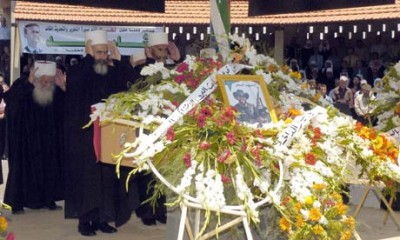The Syrian town of Jisr al-Shughour was besieged by columns of government tanks on Tuesday night as the army massed for what is feared will be an all-out assault on residents it claims killed more than 120 security force members over the weekend.

By nightfall most inhabitants had fled to nearby Turkey before the expected sharp escalation in a three-month uprising that has pitched largely unarmed demonstrators against a regime using increasingly lethal force to suppress the gravest threat to its four-decade rule.
Jisr al-Shughour, a town of 41,000 people, was largely abandoned. The hospital stood empty and the intelligence headquarters, which had been the scene of an uprising on Sunday, was now a looted and empty shell, according to three men who had stayed behind.
Human rights activists in Damascus said 59 civilians had been confirmed killed. However they feared the final number was likely to be more than 100.
The prospect of the imminent operation has stirred the ghosts of an infamous assault on the town of Hama 29 years ago, in which tens of thousands of residents were killed by the former president Hafez al-Assad after they launched a failed challenge to his authority.
Assad’s son, President Bashar al-Assad, is now facing a more serious threat, with sustained protests in many Syrian towns and cities that are steadily eroding the iron-clad rule of the Assad dynasty.
The siege of Jisr al-Shughour appears to mark a turning point in the popular rebellion, inspired by revolutions in Egypt and Tunisia. The Syrian information minister, Mohammed al-Shaar, insisted on Monday night that residents had taken up arms and turned on security forces.
Exactly what happened is not yet clear, but anecdotal evidence emerging from the town suggested that armed clashes did take place. One witness told the Guardian that some officers from the security headquarters had switched allegiances and were shot by loyalists from inside the building.
“They were killing the defecting officers,” said one local speaking by telephone. “The people came to defend them and then they had to defend themselves. There was a battle.”
Another man, who did not want to be identified, also said that some officers had switched sides. The Syrian government refused to acknowledge that any mutiny had occurred. However, it did concede that forces inside the town had “lost control for intermittent periods”. Another government official confirmed that some government weapons were now in the hands of residents. The haul included five tonnes of dynamite, the information ministry spokesman Reem Haddad told the BBC.
Shaar said the military would “not stay silent” and a move to retake the town was expected before daybreak. “The army will carry out their national duty to restore order,” he said.
Authorities in Turkey said it had received several hundred refugees who had crossed the border, many of whom had wounds. Several thousand more villagers are thought to have fled south towards Aleppo and east into farmlands. It is not known how many residents have stayed behind.
“I know that people are waiting for the army,” said one Syrian exile in London. “I have spoken to people there today and they are preparing to fight them.”
If claims of an armed rebellion are proven, it would mark the first time that citizens had taken up weapons in large numbers. Protests have been taking place at least weekly in many cities, including the capital, Damascus. Human rights groups claim that more than 1,000 people have been killed, nearly all of them demonstrators campaigning for widespread democratic reforms.
Weekly death tolls have risen sharply over the past fortnight, placing growing pressure on Assad. Damascus has been anxious to cast the uprising as a series of clashes with armed gangs who are backed by foreign powers aiming to topple the government.
The US has imposed sanctions on Assad and members of his inner circle and there are increasing signs that Europe has lost a one-time belief that Assad is a reformer constrained by the society he rules.
The UN has stopped short of imposing on Syria the same sort of security resolutions as those directed at Libya and has ruled out military intervention, and Russia has indicated it would veto any UN attempt to increase the pressure on its long-term ally.
Analysts in Damascus said they feared the government was willing to push the country into a violent struggle as it tried to cling to power. Their view was backed by diplomats in Beirut, who said regime figures were likely to further destabilise neighbouring Lebanon if pressure on them continued to mount.
Israel has accused Damascus of orchestrating protests in the Golan Heights along the ceasefire line between both countries to create a diversion from its domestic troubles.
The uprising broke out in mid-March, initially calling for reforms but escalating into demands for the toppling of the regime after a series of brutal crackdowns that spread to most major towns and cities in the country.
“Our line is that protesters either go out peacefully, or they don’t go out at all,” said one religious man in Damascus who is supporting the protests.
By: Martin Chulov in Beirut and Nidaa Hassan in Damascus
Nidaa Hassan is a pseudonym for a journalist in Damascus

Leave a Reply
You must be logged in to post a comment.